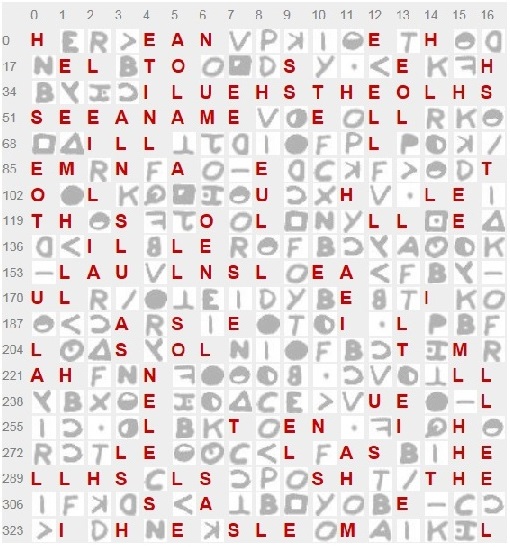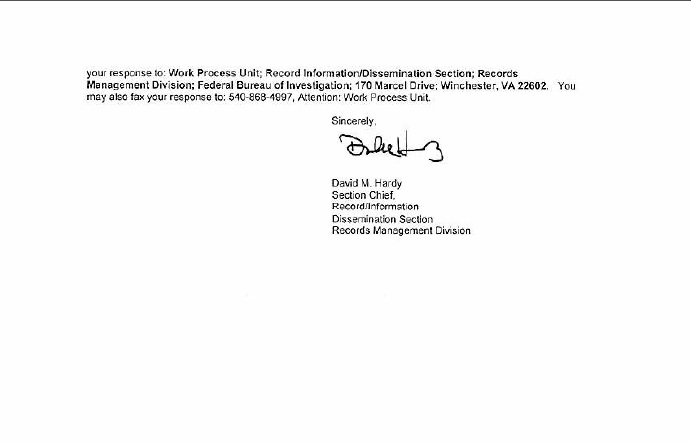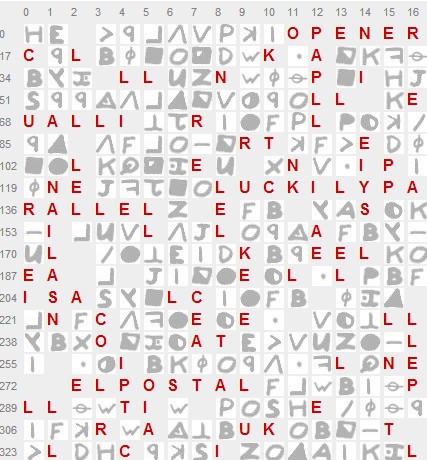..but only partially. Here we got some solid statistic out of 3.2m letters..
http://tigger.uic.edu/~jleon/mcs425-s06 … r_freq.pdf
indicating that the TT and LL combination is the most frequent one in english language. The ‘++’ overall occurs three times in the 340 cipher, therefore – extrapolated to 10,000 – this is equal to a frequency of 88 per 10,000 letters. This is indicating that ‘+’ is either representing the letter ‘L’ or the letter ‘T’, all this assuming a similar cipher method like the 408.
Selecting the usage of letters in the Zodiac letters (I took wikisource, copy paste, delete blanks) leads to an overall of approximately 16,602 letters Z had used. Among those, Z had used ‘TT’ about 61 times per 10,000 letters and ‘LL’ about 113 times per 10,000 letters. Both is ‘similarly close’ to the frequency (88 per 10,000) of ‘++’ in the cipher. The letter ‘EE’ only occurs 41 times per 10,000 letters and therefore, like the other letters, might be ruled out. Even ‘LL’ and ‘TT’ should (statistically) occur only 56 times per 10,000, but in fact Z had used the ‘++’ 88 times per 10,000, therefore 57% more often than expected.
So which one is representing the ‘+’ symbol, the letter ‘L’ or the letter ‘T’? We now must assume as there are two possibilities: ‘+’ solely representing one letter or ‘+’ being part of a sequence with more symbols representing one letter. I now make a bet: The ‘+’ occurs about 7% in the 340 and we do know, from the 408, that in fact there have been letters being represented by single symbols as well as by sequences of symbols. So I just bet that the ‘+’ is representing one letter without any other symbols representing it. If I loose my bet, the ‘+’ should for sure represent the letter ‘T’.
But I do bet otherwise, which is why I have a closer look on another statistic: How often does the ‘+’ (not the ‘++’) occur in the cipher? 24 times, which is about 7.06%. In any english text, the letter ‘T’ should occur about 9.25. Therefore ‘+’ is being ruled out for two reasons: ‘T’ would occur quite seldom compared to a normal statistic text AND do we know that Z had used the ‘++’ specifically more often (+57%) than any double letter combination normally would be.
But what about the letter ‘L’? This should occcur about 4.14% in any english text (and is conform with the double letter frequency mentioned above). Combining this with our knowledge (!) that Z had used the double letter ‘++’ about 57% more often than a normal english text would do (88 times vs. 56 times, based on 3,2m letters).
We do take this for granted and take the standard ‘L’ frequency and combine it with the fact that Z had used the ‘++’ 57% (!) more frequently than any double letter would be expected to be used.
4.14 x 1.57 = 6.50%
Delivering us the expected frequency of the letter ‘L’ in Z’s cipher text, this of course under the side condition that the double letter has been used 57% more often than normal.
In fact the ‘+’ occurs 24 times in the cipher text, therefore with a frequency of 7.06%. Comparing those two figures, we end up with 7.06/6.50 = 1,09 telling me some things:
A.) Z had used a double letter combination 57% more often than expected (statistically significant)
B.) ‘LL’ and ‘TT’ are the only double letter combinations which therefore are potential candidates for ‘++’
C.) Considering A.) the only matching letter is ‘L’ because ‘T’ would lead to a frequency of 14.5% (9.25%x1.57) which is not suitable to the frequency of ‘+’ (7.06%)
D.) Suitable in fact is the frequency of ‘+’ (7.06%) compared to the frequency of ‘L’, still under the side condition of a more frequent double letter usage (6.50%).
E.) According to this, Z has used the letter ‘L’ only 1.09 times more often than a normal english text would do (9% deviation, which should absolutely be ok for a frequency of letters).
F.) All this considered under the assumption that ‘+’ is solely representing one alphabetical letter.
So if my bet is right, ‘+’ is representing the letter ‘L’.
QT
http://scottbryce.com/cryptograms/stats.htm
*ZODIACHRONOLOGY*
QT-
I think that your post assigns a bit too much authority to normal distributions. Although it is a bit unpractical, Zodiac’s 340 may not follow any standard allocation.
Just as an illustration, "Gadsby," a 1939 publication consisting of 50,000+ words actually omits what would normally turn up as a common sign in most writing. It isn’t
too bad of a book, in fact. Also, "A Void," a short story from 1969 also has no application of it.
Both works prohibit a COMMON glyph. What is it that is missing?
A singular symbol, which is also not in this post. Until now.
E
-glurk
(Do I think that Zodiac could possibly constrain his writing, or try to mystify and blur things? Naturally!)
——————————–
I don’t believe in monsters.
That has to be reply of the year! ![]()
It isn’t. He can’t spell "Gatsby".
It is in fact right that normal distributions should work occasionally, but not always. This is a vary statistic, but imo it is also obvious that ‘+’, with 24 out of 340 letters, is a good match with the +57% showing up of ‘L’ as a twofold ‘++’. It is a crazy farrago…but as an adaption from 3,2m it is still solid and statistically significant, too.
Not using a symbol would not automatically modify any statistical data that much. Z’s writing might comply – although a bit unusual – to any normal standard writing statistic, as wording will always do.
QT
(without E)
*ZODIACHRONOLOGY*
He wasn’t trying to.
http://en.wikipedia.org/wiki/Gadsby_(novel )Gotcha.
I bloody knew it. As soon as I’d hit send I thought….hold on a minute lol. Well it’ll serve to avoid anyone else wondering.
Why so much confusion? Perhaps a correct web address that works might be better?
http://en.wikipedia.org/wiki/Gadsby_(novel)
Anyways, I wasn’t trying to be a smart-ass. I just think that Zodiac was aware of character frequencies and had the power, competency and aptitude to construct
a message that he intended to fit into his greater aim or design. Character frequencies in short messages are just NOT the same as in extended ones!
One just cannot expect a short passage such as the Z340 to use the standard distribution that would be found in more protracted texts. I’m quite certain!
I am not sure, though (by any means) that Zodiac used this technique in the 340 cipher, but I do think he might have. It’s within his capacity, I think.
I’m sorry about the appearance of the one common missing character in the wikipedia internet address above. It was mandatory! ![]()
-gurk
——————————–
I don’t believe in monsters.
![]() I’ll be glad when you all solve this cypher. I’ve developed a permanent headache from trying to understand what is being said.
I’ll be glad when you all solve this cypher. I’ve developed a permanent headache from trying to understand what is being said. ![]()
Give me psychology any day. ![]()
When in doubt, don’t.
Quicktrader – I have stated for awhile now that in the 340 the "+" translates as an "L". I think this is part of the cipher that Graysmith got right – he also translates "+" as an "L".
Your statistical analysis is good and provides a convincing reason to have the + be an L.
GLURK makes a valid point that while a general statistical analysis is good any particular individual, such as the Zodiac, may differ from the norm.
But look at words Zodiac used frequently – kill, killing, thrilling, shall, will. And my anecdotal observation is confirmed by QT’s work that shows Z used the "LL" more than the "TT".
Below is the 340 using Doranchak’s webtoy with just solving + as L. Give anyone any ideas to go from?
I say one other possible translation worth exploring could be S99=SEE.
In the 408 code an E=E and a backwards R=R, so that may provide a reason to at least try S=S.
Also in the 408 code 9=E.
This is the fourth line of the unsolved 340 and beneath it is the fourth line of the proposed solution.


So I also think at least two other parts of the Graysmith attempt are probably correct – the end of the 3rd line and 4th line SEE A NAME – here is what you get plugging those in.

IF…QT and I are right about +=L, and I am right about SEE A NAME, then what we have above should or could provide a good start for a computer based attempt to solve the rest of the cipher.
MODERATOR
AK-
The image you posted above has both the + sign AND the ‘zodiac’ sign assigned as the letter L.
33 of them, in a 340 char. message. 9.71% of the message. What the L?
-glurk
——————————–
I don’t believe in monsters.
AK-
The image you posted above has both the + sign AND the ‘zodiac’ sign assigned as the letter L.
33 of them, in a 340 char. message. 9.71% of the message. What the L?
-glurk
Glurk – I think this is the key part of QT’s post(emphasis added):
Selecting the usage of letters in the Zodiac letters (I took wikisource, copy paste, delete blanks) leads to an overall of approximately 16,602 letters Z had used. Among those, Z had used ‘TT’ about 61 times per 10,000 letters and ‘LL’ about 113 times per 10,000 letters. Both is ‘similarly close’ to the frequency (88 per 10,000) of ‘++’ in the cipher. The letter ‘EE’ only occurs 41 times per 10,000 letters and therefore, like the other letters, might be ruled out. Even ‘LL’ and ‘TT’ should (statistically) occur only 56 times per 10,000, but in fact Z had used the ‘++’ 88 times per 10,000, therefore 57% more often than expected.
But I do bet otherwise, which is why I have a closer look on another statistic: How often does the ‘+’ (not the ‘++’) occur in the cipher? 24 times, which is about 7.06%. In any english text, the letter ‘T’ should occur about 9.25. Therefore ‘+’ is being ruled out for two reasons: ‘T’ would occur quite seldom compared to a normal statistic text AND do we know that Z had used the ‘++’ specifically more often (+57%) than any double letter combination normally would be.
But what about the letter ‘L’? This should occcur about 4.14% in any english text (and is conform with the double letter frequency mentioned above). Combining this with our knowledge (!) that Z had used the double letter ‘++’ about 57% more often than a normal english text would do (88 times vs. 56 times, based on 3,2m letters).
We do take this for granted and take the standard ‘L’ frequency and combine it with the fact that Z had used the ‘++’ 57% (!) more frequently than any double letter would be expected to be used.
4.14 x 1.57 = 6.50%
Delivering us the expected frequency of the letter ‘L’ in Z’s cipher text, this of course under the side condition that the double letter has been used 57% more often than normal.
In fact the ‘+’ occurs 24 times in the cipher text, therefore with a frequency of 7.06%. Comparing those two figures, we end up with 7.06/6.50 = 1,09 telling me some things:
A.) Z had used a double letter combination 57% more often than expected (statistically significant)
B.) ‘LL’ and ‘TT’ are the only double letter combinations which therefore are potential candidates for ‘++’
C.) Considering A.) the only matching letter is ‘L’ because ‘T’ would lead to a frequency of 14.5% (9.25%x1.57) which is not suitable to the frequency of ‘+’ (7.06%)
D.) Suitable in fact is the frequency of ‘+’ (7.06%) compared to the frequency of ‘L’, still under the side condition of a more frequent double letter usage (6.50%).
E.) According to this, Z has used the letter ‘L’ only 1.09 times more often than a normal English text would do (9% deviation, which should absolutely be ok for a frequency of letters).
F.) All this considered under the assumption that ‘+’ is solely representing one alphabetical letter.
AK WILKS: Do you disagree with his work, or his conclusions?
In the second cipher I posted I have some aside from the +=L, I also have some debatable word solves from the 3rd and 4th lines. Given how often Zodiac used words with LL or L, I think the numbers are not out of line, in fact they make sense – kill, killing, thrilling, collecting, shall, will, all, like, people, wild, girl, slaves, slow, animal, afterlife.
Maybe someone – or me – can count the total letters in the 408 and total appearance of "L" and see where that gets us. Or maybe QT has the statistic for total use of L as a single or double in all of the Zodiac letters.
By my rough quick count, the letter "L" appears 33 times in the 408 code. About 8.1% of the letters are "L", which is about double normal usage, as it happens that many words Z liked to use have either L or LL in them. So if Z used "L" 8.1% of the time in the 408, it seems to me that 9.7% use in the 340 code is within normal deviation, really only two more uses of a word like kill, killing, collecting, etc., would do it. And if we strike the untranslated last 18, leaving us 390 translated letters, the 33 uses of "L" amount to 8.5%, which is even closer to my proposed 9.7%. in the 340 code
I think the major find of QT is that he lays out a solid statistical reason to translate the + as an L, at least as a starting working hypothesis. If he is right, he has solved one character in the 340, which is something that nobody, FBI, police, amateurs, has yet done.
Glurk do you agree he lays out a good reason to at least consider the ++ as LL?
MODERATOR
AK-
I don’t have the time (or patience) at the moment to go over everything point-by-point, so I’ll just make my counter-arguments for consideration.
Yes, Z did use the letter L quite a bit in his writings, and certainly in the 408. In fact, all of those LL’s in the 408 are a large part of what helped the Hardens
to solve it as quickly as they did. They wrote about their process, in the Aug. 9 1969 "A ‘Murder Code’ Broken" article indicating the use of "kill" once,
"killing" twice, and "thrilling" and "killed" once each. The cipher also used "all" twice, and "will" three times.
Now, did Z read that article? I’m going to bet he did. After reading how his 408 was broken so quickly, did he naïvely just keep on using L and LL in the 340?
I’m going to bet that he did not. ![]()
And also, QT’s premise is based on the possibility that the 340 is a homophonic cipher constructed in the same way as the 408. Speaking only for myself, I am
absolutely convinced that it is not. I’m certain that something else is going on. Transposition, using a "route cipher," or something else. I don’t know.
One of the first things we tried with ZkDecrypto was to lock the + symbol as L and let it try to solve the rest. You just don’t get anything readable, despite
the fact that the program solves pretty much everything thrown at it, and there were many example ciphers made to try to ‘confuse’ it.
I wouldn’t be terribly surprised if the solution to the 340 contains no L at all, as my page 1 previous post above does not (well, except for one). I believe that Z was
very clever (though not a genius), read pretty much every article written about him, and adapted/reacted to them.
If I were to hazard a guess about the + symbol, I’d probably expect it to be a wildcard character representing multiple letters.
-glurk
——————————–
I don’t believe in monsters.
Hi Glurk,
good that you mentioned your position…just one point – why not assuming a similar cipher structure like in the 408? Not only are there more sequences than we actually would like to have, but is it also very similar in its overall appearance..imo a solution in fact is presentable – if the right one is found..in fact there are enough possibilities to try, even starting with ‘+’ = ‘L’.
This one is a dead end, but the interesting part with the + = L is also that there are at least 4 positions to start with guessing words like compeLLing etc…sadly there is no + in the first 5-8 letters, which would make guessing much easier.
QT
*ZODIACHRONOLOGY*




